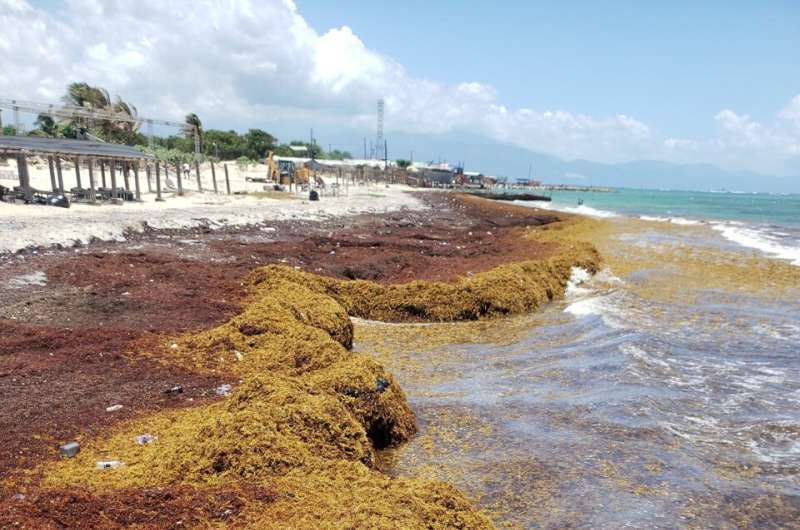Sargassum in Jamaica, August 2021. Credit: Dale Webber.
Researchers have been working to track and study floating sargassum, a prolific seaweed swamping Caribbean and West African shorelines, and causing environmental and economic harm. The study, "Changes in holopelagic Sargassum spp. biomass composition across an unusual year," is published in PNAS.
The stranded seaweed blocks fishing boats; threatens tourism; disrupts turtle nesting sites, reefs and mangroves, and releases toxic gas, which impacts human health and damages electrical equipment.
First reported by Christopher Columbus in the 15th century, floating mats of sargassum have long been present in the North Atlantic. However, since 2011, a floating population has established between West Africa and South America, and increased in size to form "the great Atlantic sargassum belt"—a 9,000km-long macroalgal bloom, visible from space and estimated to weigh 35 million tons.
The massive blooms of sargassum are thought to be down to nutrient pollution and warming seas, and vast quantities of the seaweed end up in landfill each year.
The research team, from the Universities of York and Southampton, alongside colleagues from the University of the West Indies in Jamaica and Barbados, set out to learn more about sargassum's biomass composition in order to unlock its potential to be used to produce sustainable products.
While the seaweed is an abundant biomass, its possible uses are limited due to its high arsenic content.
First author of the study Dr. Carla Machado, a research associate in the Department of Biology, said, "The small quantities of sargassum that used to wash ashore in the Caribbean provided a habitat for turtles, crabs and fish and contributed to beach formation as it decomposed, but the vast sargassum blooms of the past decade are a global problem that will continue to grow and have a major impact in the affected countries.
"This research project has brought together international researchers specializing in biomass composition and satellite imaging to track, sample and study sargassum, providing crucial new knowledge of this little-understood macroalgae."
For a biomass to be utilized, it needs to be consistent in its composition; this ensures it can be processed efficiently and behave predictably during production.
The results of the study showed that, overall, the biochemical composition of sargassum is consistent throughout the year. The researchers tested different processing methods for the seaweed, including shade-drying or freezing, and found the protein content of the seaweed stayed the same. However, the method of processing did affect levels of other components such as alginate, which can be processed for many applications, including biomaterials.
The researchers collected samples of sargassum in Jamaica throughout 2021, which coincided with the April 2021 eruption of La Soufrière on the Caribbean island of Saint Vincent.
Using drift patterns, the authors calculated that the sargassum samples they collected in August 2021 would have spent approximately 50 days exposed to ash from the eruption.
They found that seaweed that had likely been in contact with volcanic ash contained less arsenic, but had accumulated other elements including nickel and zinc.
Lead author of the study, Dr. Thierry Tonon from the Department of Biology at the University of York said, "Understanding sargassum's response to environmental conditions is crucial for unlocking its biology and potential value.
"With the great sargassum belt also receiving additional nutrients from Sahara dust that blows across the Atlantic, huge quantities of the seaweed washing up on coastlines looks set to become the new normal."
There is much more work to be done to increase understanding about sargassum and how it is going to behave in years to come, the researchers say. This will provide a body of evidence that could inform an international response to the problems it poses for people and the environment and transform it into something useful.
Professor Robert Marsh from the University of Southampton said, "The sargassum beaching around Jamaica in late summer 2021 carried distinct traces of the volcanic ash that settled upon it around four months earlier, just to the east of St Vincent; this novel 'volcanic tag' confirmed that sargassum arrives each summer at Jamaican beaches after a months-long journey drifting with currents from the central tropical Atlantic."
Professor Hazel A. Oxenford from the University of the West Indies said, "Volcanic ash collected in my garden from the St Vincent eruption was used to determine its chemical signature. Being able to detect those components in sargassum after it traveled more than 1,700 km across the Caribbean to Jamaica was exciting. It confirmed our predicted transport pathway for sargassum, showed that the seaweed lives for at least four months and demonstrates the marine connectivity across the region."
Professor Mona Webber from the University of the West Indies added, "It is very important for Caribbean Islands being affected by the sargassum inundation to be able to benefit from its valorization. Understanding how the sargassum we collect in Jamaica has changed en route to our shores and factors that could affect especially the arsenic content, will propel us towards safe use of the algal biomass."
The study was carried out in collaboration between the Universities of York, Southampton and the West Indies.
More information: Thierry Tonon et al, Changes in holopelagic Sargassum spp. biomass composition across an unusual year, Proceedings of the National Academy of Sciences (2024). DOI: 10.1073/pnas.2312173121. doi.org/10.1073/pnas.2312173121
Journal information: Proceedings of the National Academy of Sciences
Provided by University of York























